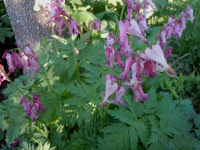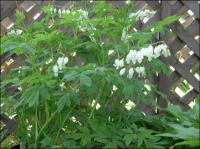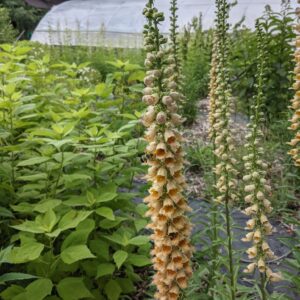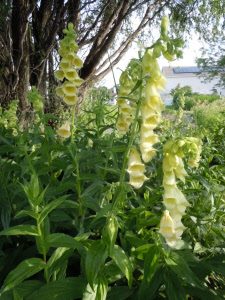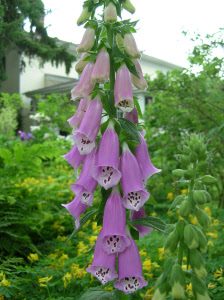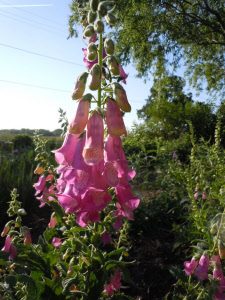Plants for Hummingbirds
Showing 17–24 of 82 results
-
Dicentra eximia syn Lamprocapnos , Fringed bleeding heart Z 4-8
May to October, dangling rose pink heart-shaped panicles
OUT OF STOCK
May to October dangling rose pink heart-shaped panicles among fern-like, grey-green foliage. They appear delicate but are not.
Size: 8” x 8”
Care: Part shade, moist to moist well-drained soil
Native: Mountains from New York to Georgia
Wildlife Value: Nectar source for hummingbirds & White swallowtail butterfly.Dicentra derived from Greek dis meaning two and kentros meaning spurs. Introduced to gardens by Quaker planthunter and nurseryman John Bartram (1699-1777) in mid-1700’s. Recommended by Gertrude Jekyll, mother of mixed perennial borders, in 1908.
**LISTED AS OUT OF STOCK BECAUSE WE DO NOT SHIP THIS ITEM. IT IS AVAILABLE FOR PURCHASE AT OUR RETAIL LOCATION.
-
Dicentra spectablis Alba syn Lamprocapnos spectabilis White bleeding heart Z 3-9
Dangling alabaster, heart shaped blossoms
May – June Legendary dangling alabaster, heart shaped blossoms. One of the best.
Size: 36" x 18"
Care: Part shade to shade in moist well-drained soil.
Native: JapanDicentra derived from Greek dis meaning “two” and kentros meaning “spurs.” The white form in gardens in the West 1877.
-
Dicentra spectablis syn Lamprocapnos spectabilis Bleeding Heart Z 3-9
May - June legendary dangling dark pink heart shaped blossoms. One of the best.
OUT OF STOCK
From May through June legendary dangling, dark pink heart-shaped blossoms. One of the best.
Size: 36" x 18"
Care: Part shade to shade, moist well-drained soil.
Native: Japan
Awards: Royal Horticultural Society Award of MeritDicentra derived from Greek dis meaning “two” and kentros meaning “spurs” because the flowers have two spurs. Spectabilis means “worthy of notice.” The Bleeding heart was a favorite garden plant in China for centuries before its discovery by Europeans. Introduced to the West in 1846 after Robert Fortune found it growing on the Island of Chusan and sent it to the Horticultural Society of London. It became an immediate sensation in England. By 1866 the Bleeding heart was available in America.
**LISTED AS OUT OF STOCK BECAUSE WE DO NOT SHIP THIS ITEM. IT IS AVAILABLE FOR PURCHASE AT OUR RETAIL LOCATION.
-
Digitalis ferruguina Rusty foxglove Z 4-7
Mottled rusty bells with brown speckled throats & hairy lips clothe the spikes in mid-summer. One of internationally known garden designer Piet Oudolf’s 100 “MUST HAVE” plants, Gardens Illustrated 94 (2013)
Mottled rusty bells with brown speckled throats & hairy lips clothe the spikes in mid-summer. One of internationally known garden designer Piet Oudolf’s 100 “MUST HAVE” plants, Gardens Illustrated 94 (2013)
Size: 4-5' x 18"
Care: sun to part shade in moist well-drained soil.
Native: Southern Europe and Balkans
Awards: England’s Royal Horticultural Society Award of Merit. Elisabeth Carey Miller Botanical Garden Great Plant Pick.The word ‘fox’ is said to be a corruption of ‘folk,’ meaning the ‘little folk’ or fairies. Foxgloves reputedly had the power to ward off witches and return children kidnapped by fairies Ferruginea means rust-colored from ferric describing metal containing iron. This species in garden cultivation since at least the 1590’s.
-
Digitalis grandiflora Yellow foxglove Z 4-8
Early to midsummer spires of moon yellow bells dress the flower spikes. Will rebloom if deadhead.
Early to midsummer spires of moon yellow bells dress the flower spikes. Will rebloom if deadheaded.
Size: 36" x 18"
Care: Sun to part sun, moist well-drained soil.
Native: Europe to Siberia and south to Turkey
Awards: Royal Horticultural Society Award of Merit. Elisabeth Carey Miller Botanical Garden Great Plant Pick.Liberty Hyde Bailey called foxgloves: “old-fashioned and dignified… The word ‘fox’ is often said to be a corruption of ‘folk,’ meaning the ‘little folk’ or fairies.” Foxgloves reputedly had the power to ward off witches and return children kidnapped by fairies. This species grown in the Eichstätt Garden, the garden of Johann Konrad von Gemmingen, prince bishop of Eichstätt in Bavaria, c. 1600. Common in Elizabethan cottage gardens.
-
Digitalis lutea Straw foxglove, Small yellow foxglove Z 3-9
Mid-summer, honey yellow, small bells encircle the flower spike
Mid-summer, honey yellow, small bells encircle the flower spike.
Size: 24" x 12"
Care: Sun to part shade in moist well-drained soil.
Native: Central Europe south to NW AfricaThe word ‘fox’ is often said to be a corruption of ‘folk,’ meaning the ‘little folk’ or fairies.” Foxgloves reputedly had the power to ward off witches and return children kidnapped by fairies. This species identified by Bavarian physician Leonhart Fuchs (1501-1566) in 1542. D. lutea mentioned in Gerard’s Herball in 1632.
-
Digitalis purpurea Foxglove Z 4-8
pink, purple or white spires of spotted bells
OUT OF STOCK
Early summer pink, purple or white spires of spotted bells. Beautiful.
Size: 3-5' x 24"
Care: Part shade moist well-drained soil. Deer resistant
Native: Great Britain,west and central Europe east to Scandinavia, often escapes.Druids were fond of this Foxglove because it flowered at the same time as their midsummer sacrifice. First described by German physician and botanical author Leonhard Fuchs (1501-1566). Grown in Medieval gardens. The plant’s use as a heart stimulant was discovered in 1775 by English physician William Withering. The word ‘fox’ is said to be a corruption of ‘folk,’ meaning the ‘little folk’ or fairies,” having the power to ward off witches and return children kidnapped by fairies. Cultivated in America since 1700’s, with the first documented reference of American cultivation in 1748 by Peter Kalm, a student of Linneaus and a Swedish botanist who explored colonial America for plants. Pressed specimen in Emily Dickinson’s herbarium.
-
Digitalis thapsi Spanish foxglove Z 5-9
Spikes of purple, rose-spotted trumpets in early summer. True perennial
OUT OF STOCK
Spikes of purple, rose-spotted trumpets in early summer. True perennial.
Size: 18” x 12”
Care: sun to part shade in moist well-drained soil.
Native: Spain & PortugalGrown in the botanical gardens of Moscow by 1752. Philip Miller (1691-1771), chief gardener at London’s Chelsea Physic Garden, received seeds from Spain and grew this by 1760’s

